
Which of the following nitroso compounds are in a dynamic equilibrium with their tautomers?
(A)
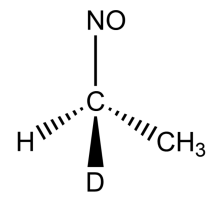
(B)
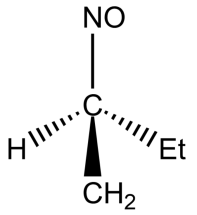
(C)
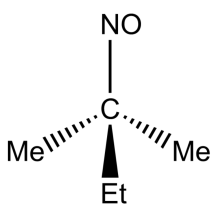
(D)
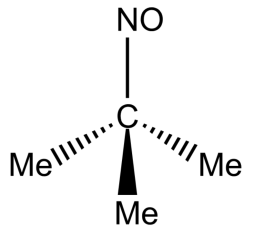




Answer
472.2k+ views
Hint: The isomers of compounds which differ only in the position of the protons and electrons are known as tautomers. When a reaction between such compounds occurs, there is only a transfer of protons.
Complete Step by step answer:
-The phenomenon where a single chemical compound tends to exist in two or more interconvertible structures that are different in terms of the relative position of one atomic nucleus which is generally the hydrogen is known as tautomerism.
-Tautomerism is also known as desmotropism.
- For a compound to exhibit tautomerism, it must have the following structural requirements-
(i) the compound must have at least one alpha hydrogen
(ii) the compound must contain polar molecules and weakly acidic functional groups.
(iii) generally, tautomerism occurs in planar or non-planar molecules.
-Let us now see tautomerism in nitroso compounds.
The shifting of hydrogen produces two forms of tautomers of nitroso compounds, which are ketoxime and aldoxime.
$C{{H}_{3}}-N=O(Ketoxime)\leftrightarrow C{{H}_{2}}=N-OH(Aldoxime)$
-Let us now match with the options and find out which one does exhibit all the structural requirements to be in dynamic equilibrium with their tautomers-
-In option A, the compound has alpha hydrogen, thus it can exhibit tautomerism.
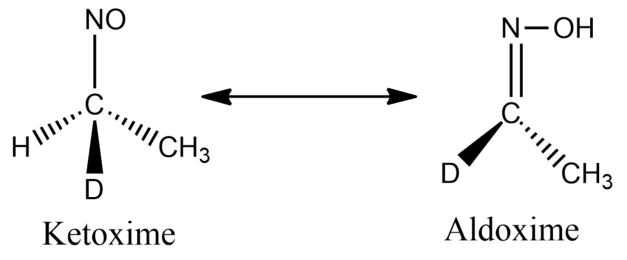
-In option B, the compound has alpha hydrogen, thus it can exhibit tautomerism.
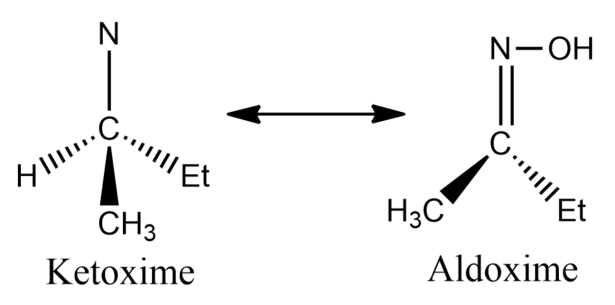
-In option C, the compound does not have alpha hydrogen, hence it will not exhibit tautomerism.
-In option D, the compound does not have alpha hydrogen, hence it will not exhibit tautomerism.
Therefore, the correct answers are options A and B.
Note: Tautomerism happens in the presence of a catalyst which can be either acid-catalyst or base catalyst. In presence of acid-catalyst, the protonation occurs and cation will be delocalized followed by deprotonation occurring in the adjacent position of the cation. In the presence of base-catalyst, the deprotonation occurs in the first step. In this case, anion delocalization occurs instead of cation delocalization and finally, protonation occurs to the different position of the anion.
Complete Step by step answer:
-The phenomenon where a single chemical compound tends to exist in two or more interconvertible structures that are different in terms of the relative position of one atomic nucleus which is generally the hydrogen is known as tautomerism.
-Tautomerism is also known as desmotropism.
- For a compound to exhibit tautomerism, it must have the following structural requirements-
(i) the compound must have at least one alpha hydrogen
(ii) the compound must contain polar molecules and weakly acidic functional groups.
(iii) generally, tautomerism occurs in planar or non-planar molecules.
-Let us now see tautomerism in nitroso compounds.
The shifting of hydrogen produces two forms of tautomers of nitroso compounds, which are ketoxime and aldoxime.
$C{{H}_{3}}-N=O(Ketoxime)\leftrightarrow C{{H}_{2}}=N-OH(Aldoxime)$
-Let us now match with the options and find out which one does exhibit all the structural requirements to be in dynamic equilibrium with their tautomers-
-In option A, the compound has alpha hydrogen, thus it can exhibit tautomerism.

-In option B, the compound has alpha hydrogen, thus it can exhibit tautomerism.

-In option C, the compound does not have alpha hydrogen, hence it will not exhibit tautomerism.
-In option D, the compound does not have alpha hydrogen, hence it will not exhibit tautomerism.
Therefore, the correct answers are options A and B.
Note: Tautomerism happens in the presence of a catalyst which can be either acid-catalyst or base catalyst. In presence of acid-catalyst, the protonation occurs and cation will be delocalized followed by deprotonation occurring in the adjacent position of the cation. In the presence of base-catalyst, the deprotonation occurs in the first step. In this case, anion delocalization occurs instead of cation delocalization and finally, protonation occurs to the different position of the anion.
Recently Updated Pages
How do you factor x2 + x 20 0 class 9 maths CBSE

How do you solve y6x and 2x+3y20 using substitutio class 9 maths CBSE

Chipko movement originated in Gopeshwar in A 1953 B class 9 biology CBSE

The adjacent sides in the parallelogram are supplementary class 9 maths CBSE

The compound used in plastic industry is A Vinyl acetate class 9 chemistry CBSE

How do you solve for y in 2left y dfrac12 right 4left class 9 maths CBSE

Trending doubts
According to Bernoullis equation the expression which class 11 physics CBSE

Draw a diagram of nephron and explain its structur class 11 biology CBSE

Differentiate between calcination and roasting class 11 chemistry CBSE

A solution of a substance X is used for white washing class 11 chemistry CBSE

What is spore formation class 11 biology CBSE

10 examples of friction in our daily life




